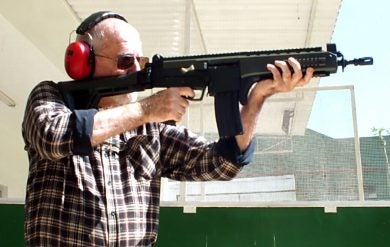The use of sub-caliber ammunition in firearms — and artillery pieces as well — is far from new and its purpose is self-evident: to reduce training costs. For those of you living in countries where ammo rounds are plenty and very affordable for individuals and, much more so, for established institutions such as armed forces and law enforcement agencies, the question at hand may seem irrelevant. This is not the case for a whole lot of countries around the world, whose economies have to deal with tight purse strings all the time. In nations where armed and LE forces priorities are frequently given less-than-desirable importance by decision-making politicians, saving bucks (or whatever currency) in initial training may be the only way of giving new conscripts and rookies a barely decent firearms training program before they can be counted on to perform their duties with a minimum of quality. Got the general picture?
Brazil fits this scenario adequately. Not only are ammunitions costs, as a whole, very high, but budget restrictions also tend to limit procurement to alarming low figures. A long-time (since the mid-1960s) user of 7.62x51mm FAL rifles made by IMBEL – Indústria de Material Bélico do Brasil, the Exército Brasileiro (Brazilian Army) is now in the process of complementing it with the 5.56x45mm IA2 rifle (https://www.thefirearmblog.com/blog/2017/05/17/imbel-5-56x45mm-ia2-riflecarbine-development-status-report/) from the same manufacturer. Granted, the smaller round is also cheaper than the larger one, but still expensive in this neck of the woods. Enter the .22 Long Rifle option.

I know you aleady know, but here’s a comparative view of a .22LR round and a .223Rem. (Photo: Aaron Spuler, in TFB)
To my knowledge (please, correct me TFB readers), a .22LR round costs one-tenth of a 5.56x45mm/.223Rem unit in the U.S., while in Brazil, for reasons unknown to this writer, the rimfire round locally made by CBC – Companhia Brasileira de Cartuchos costs about one-third of the centerfire rifle round. Nevertheless, the cost difference is still enough to justify the use of the.22LR for initial training purposes here.
Before going into some detail of the IMBEL conversion kit, let’s just leave some points clear. Obviously, the lighter rounds are intended to be primarily used only in the introductory phases of rifle training, so that novices can learn the very basics of weapons handling, general safety procedures, use of sights, and, of course, firing in reduced-scale ranges. Also evidently, firing that puny cartridge from a 3kg+ rifle will generally feel (and sound!) like an air rifle is being used! Not to worry, though. At a later stage, however, the newbies will be given the real McCoy to train with and get used to such stuff as recoil, noise, flash, heat, etc. And help spend his service’s higher-cost ammunition supply!

The initial step to transform a 5.56x45mm IA2 rifle into a .22LR gun is to swing the upper and lower receivers apart and remove the top cover and the bolt/recoil spring assemblies.
Still under tests, an early example of the conversion kit was recently made available to TFB for a quick firing session at the Fábrica de Itajubá (Itajubá Factory) facilities, in Minas Gerais State. The whole thing is as straightforward as possible: get an IA2 rifle, remove the upper receiver cover, pull out the bolt and recoil spring assemblies, insert the kit assembly, close the gun again, use the supplied STANAG-type magazine (capacity still to be defined), and you’re basically ready to go. You now have, of course, a blowback-operated IA2 in your hands, but still keeping the select-fire capability. This will not add much of practical to the training syllabus, but, boy, it’s lots of fun!

A new light bolt assembly, with the respective recoil spring, then replaces the original parts. A STANAG-type magazine with a .22LR insert is used in the gun.

A closer view of the 5.56x45mm bolt and recoil spring and the integral .22LR bolt/recoil spring assembly for the IA2 rifle. Note that the forward end of the light, skeletonized bolt features an insert that fits in the chamber.

Right side view of the receiver with the kit in place, minus cover. For the record, the IA2 cold-forged barrel is 330mm (350mm, with flash hider) long, with six grooves RH, 1:10in pitch.

IMBEL’s most cooperative staff recently gave the author the opportunity for a brief, hands-on assessment of the IA2 .22LR training kit at the Fábrica de Itajubá range. An almost silent, recoiless experience…
As already mentioned, the IMBEL IA2 .22LR conversion kit is still in the development stage and will have to be submitted to an official certification testing program by the CAEx – Centro de Avaliações do Exército (Army Evaluations Center), in Rio de Janeiro, before entering series production. As the conversion to the rimfire round appears to be proceeding with no evident hindrances, I would guess that a future .22LR-only chambered IA2 might be eventually offered. The local market would love it!
(Higher-res photos available: http://imgur.com/a/KLdDV)
 Your Privacy Choices
Your Privacy Choices
